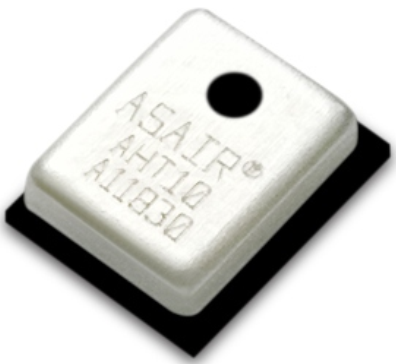This article is mainly based on ec600x onboard temperature and humidity sensor aht10 to do a small experiment of temperature and humidity detection.
Hardware introduction

Aht10 is a high-precision, fully calibrated, chip encapsulated temperature and humidity sensor. The MEMS manufacturing process ensures that the product has high reliability and excellent long-term stability. The sensor consists of a capacitive humidity sensing element connected to a high-performance CMOS microprocessor. The product has the advantages of excellent quality, ultra fast response, strong anti-interference ability and high cost performance. For details.
Aht10 communicates through I2C interface. According to the introduction of the manual. Just send the data in the following way to get the data.
-
Power on and wait for calibration data. Send 0xe1 0x08 0x00. (only need to calibrate once)
-
Trigger measurement and send 0xac, 0x33, 0x00.
-
Read the data and wait for 70ms conversion. Just read 6 bytes.

Check the schematic diagram and data manual to determine that the slave address is 0x38.
As it is an onboard module, the schematic diagram refers to the schematic diagram above, and no other external modules are required.
Software design
- Initialize aht10 sensor
- Trigger measurement
- Delay 70ms
- Read data
- Convert temperature and humidity
- Continue with step 2
import log
from machine import I2C
import utime as time
class aht10class:
i2c_log = None
i2c_dev = None
i2c_addre = None
# Initialization command
AHT10_CALIBRATION_CMD = 0xE1
# Trigger measurement
AHT10_START_MEASURMENT_CMD = 0xAC
# reset
AHT10_RESET_CMD = 0xBA
def write_data(self, data):
self.i2c_dev.write(self.i2c_addre,
bytearray(0x00), 0,
bytearray(data), len(data))
pass
def read_data(self, length):
r_data = [0x00 for _ in range(length)]
r_data = bytearray(r_data)
self.i2c_dev.read(self.i2c_addre,
bytearray(0x00), 0,
r_data, length,
0)
return list(r_data)
def aht10_init(self, addre=0x38, alise="Ath10"):
self.i2c_log = log.getLogger(alise)
self.i2c_dev = I2C(I2C.I2C1, I2C.STANDARD_MODE) #Return I2C object
self.i2c_addre = addre
self.sensor_init()
pass
@staticmethod
def aht10_transformation_temperature(data):
r_data = data
#Convert the temperature as described in the data book
humidity = (r_data[0] << 12) | (
r_data[1] << 4) | ((r_data[2] & 0xF0) >> 4)
humidity = (humidity/(1 << 20)) * 100.0
print("current humidity is {0}%".format(humidity))
temperature = ((r_data[2] & 0xf) << 16) | (
r_data[3] << 8) | r_data[4]
temperature = (temperature * 200.0 / (1 << 20)) - 50
print("current temperature is {0}°C".format(temperature))
def sensor_init(self):
# calibration
self.write_data([self.AHT10_CALIBRATION_CMD, 0x08, 0x00])
time.sleep_ms(300) # at last 300ms
pass
def ath10_reset(self):
self.write_data([self.AHT10_RESET_CMD])
time.sleep_ms(20) # at last 20ms
def trigger_measurement(self):
# Trigger data conversion
self.write_data([self.AHT10_START_MEASURMENT_CMD, 0x33, 0x00])
time.sleep_ms(200) # at last delay 75ms
# check has success
r_data = self.read_data(6)
# check bit7
if (r_data[0] >> 7) != 0x0:
print("Conversion has error")
else:
self.aht10_transformation_temperature(r_data[1:6])
def i2c_aht10_test():
ath_dev = aht10class()
ath_dev.aht10_init()
#Test ten times
for i in range(10):
ath_dev.trigger_measurement()
time.sleep(1)
if __name__ == "__main__":
i2c_aht10_test()